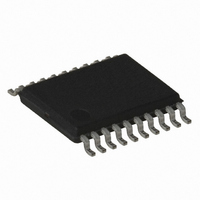ATTINY167-15XD Atmel, ATTINY167-15XD Datasheet - Page 176

ATTINY167-15XD
Manufacturer Part Number
ATTINY167-15XD
Description
MCU AVR 16K FLASH 15MHZ 20-TSSOP
Manufacturer
Atmel
Series
AVR® ATtinyr
Datasheet
1.ATTINY167-15MD.pdf
(283 pages)
Specifications of ATTINY167-15XD
Core Processor
AVR
Core Size
8-Bit
Speed
16MHz
Connectivity
I²C, LIN, SPI, UART/USART, USI
Peripherals
Brown-out Detect/Reset, POR, PWM, Temp Sensor, WDT
Number Of I /o
16
Program Memory Size
16KB (8K x 16)
Program Memory Type
FLASH
Eeprom Size
512 x 8
Ram Size
512 x 8
Voltage - Supply (vcc/vdd)
2.7 V ~ 5.5 V
Data Converters
A/D 11x10b
Oscillator Type
Internal
Operating Temperature
-40°C ~ 150°C
Package / Case
20-TSSOP
Processor Series
ATTINY1x
Core
AVR8
Data Bus Width
8 bit
Data Ram Size
512 B
Maximum Clock Frequency
16 MHz
Maximum Operating Temperature
+ 85 C
Mounting Style
SMD/SMT
3rd Party Development Tools
EWAVR, EWAVR-BL
Development Tools By Supplier
ATAVRDRAGON, ATSTK500, ATSTK600, ATAVRISP2, ATAVRONEKIT
Minimum Operating Temperature
- 40 C
For Use With
ATSTK600-SOIC - STK600 SOCKET/ADAPTER FOR SOIC
Lead Free Status / RoHS Status
Lead free / RoHS Compliant
- Current page: 176 of 283
- Download datasheet (5Mb)
15.5.9
176
ATtiny87/ATtiny167
xxERR Flags
LERR bit of the LINSIR register is an logical ‘OR’ of all the bits of LINERR register (see
tion 15.5.13 “Interrupts” on page
After each LIN error, the LIN controller stops its previous activity and returns to its withdrawal
mode (LCMD[2..0] = 000
Writing 1 in LERR of LINSIR register resets LERR bit and all the bits of the LINERR register.
• LBERR = LIN Bit ERRor.
• LCERR = LIN Checksum ERRor.
• LPERR = LIN Parity ERRor (identifier).
• LSERR = LIN Synchronization ERRor.
• LFERR = LIN Framing ERRor.
• LTOERR = LIN Time Out ERRor.
• LOVERR = LIN OVerrun ERRor.
• LABORT
A unit that is sending a bit on the bus also monitors the bus. A LIN bit error will be flagged
when the bit value that is monitored is different from the bit value that is sent. After
detection of a LIN bit error the transmission is aborted.
A LIN checksum error will be flagged if the inverted modulo-256 sum of all received data
bytes (and the protected identifier in LIN 2.1) added to the checksum does not result in
0xFF.
A LIN parity error in the IDENTIFIER field will be flagged if the value of the parity bits does
not match with the identifier value. (See LP[1:0] bits in
Register - LINIDR” on page
corrupted parity bits and a corrupted identifier. The hardware does not undertake any
correction. However, the LIN slave application has to solve this as:
- known identifier (parity bits corrupted),
- or corrupted identifier to be ignored,
- or new identifier.
A LIN synchronization error will be flagged if a slave detects the edges of the SYNCH field
outside the given tolerance.
A framing error will be flagged if dominant STOP bit is sampled.
Same function in UART mode.
A time-out error will be flagged if the MESSAGE frame is not fully completed within the
maximum length T
IDENTIFIER fields (see
Overrun error will be flagged if a new command (other than LIN Abort) is entered while
‘Busy signal’ is present.
In UART mode, an overrun error will be flagged if a received byte overwrites the byte stored
in the serial input buffer.
LIN abort transfer reflects a previous LIN Abort command (LCMD[2..0] = 000) while ‘Busy
signal’ is present.
Frame_Maximum
b
) as illustrated in
Section 15.5.10 “Frame Time Out” on page
186). A LIN slave application does not distinguish between
178). There are eight flags:
by any slave task upon transmission of the SYNCH and
Figure 15-11 on page
Section 15.6.8 “LIN Identifier
175.
177).
7728G–AVR–06/10
Sec-
Related parts for ATTINY167-15XD
Image
Part Number
Description
Manufacturer
Datasheet
Request
R

Part Number:
Description:
Manufacturer:
Atmel Corporation
Datasheet:

Part Number:
Description:
Manufacturer:
Atmel Corporation
Datasheet:

Part Number:
Description:
MCU AVR 16K FLASH 15MHZ 32-QFN
Manufacturer:
Atmel
Datasheet:

Part Number:
Description:
IC MCU AVR 16K FLASH 20TSSOP
Manufacturer:
Atmel
Datasheet:

Part Number:
Description:
MCU AVR 16K FLASH 15MHZ 32-QFN
Manufacturer:
Atmel
Datasheet:

Part Number:
Description:
MCU AVR 16K FLASH 15MHZ 20-SOIC
Manufacturer:
Atmel
Datasheet:

Part Number:
Description:
MCU AVR 16K FLASH 15MHZ 20-TSSOP
Manufacturer:
Atmel
Datasheet:

Part Number:
Description:
IC MCU AVR 16K FLASH 20SOIC
Manufacturer:
Atmel
Datasheet:










